Haworthia cymbiformis var. setulifera
Haworthia cymbiformis (Haw.) Duval var. setulifera (Poelln.) M.B.Bayer
Family: Asphodelaceae
Common names: cliff haworthia (Eng.); krans-dwergaalwyntjie (Afr.)
Introduction
Haworthia cymbiformis var. setulifera is a dwarf, compact growing, cliff-hugger, consisting of dense clumps of numerous, small rosettes of sparingly toothed, succulent, green leaves, and small white flowers in spring and early summer. It grows on cliffs from the Kei River to the Mbashe River in the Eastern Cape. Best grown in containers.
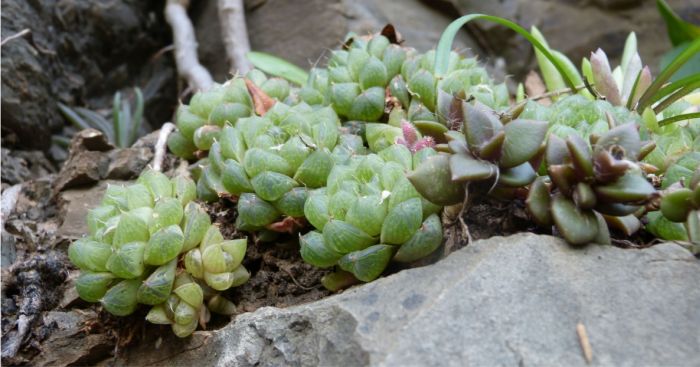
Fig. 1. Haworthia cymbiformis var. setulifera growing along the Kei River, sharing its cliff habitat with Anacampseros lanceolata, Caputia scaposa and Cyrtanthus sanguineus.
Description
Description
Plants dwarf-sized, neatly rosulate, prolific from the base, forming small, rounded clusters up to 80 mm in diameter and consisting of up to 25 heads. Rosettes about 45 mm in diameter. Roots grey, terete, up to 4 mm in diameter. Leaves, up to 25, soft, oblanceolate to obclavate, patent (spreading) to incurved, translucent, and with striate apices; upper side flat to channelled or slightly convex; lower surface cymbiform; leaf surface smooth, green, becoming pinkish green during dry periods; margin with soft, bristle-like teeth; apex obtuse to acute, sometimes with distinct, large translucent windows, mucronate. Inflorescence solitary, racemose, 170 mm long, 12–20-flowered in distal half; bracts white, clasping, up to 3 mm long, ovate-acuminate; pedicels 2 mm long. Perianth tubular, curved, ascending-spreading, 15 mm long, white with purplish green mid-stripe. Capsule 8 × 3 mm. Seed 2.5 × 1.5 mm, angular, grey-black. Flowering is mainly from spring to early summer (October–November). Seeds are dispersed by wind in summer and early autumn.
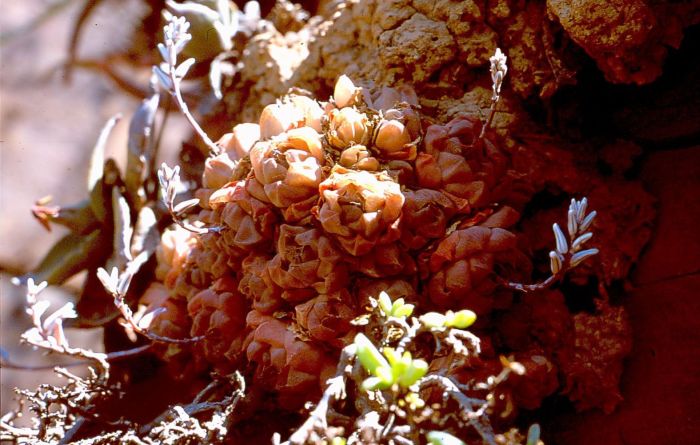
Fig. 2. A cluster Haworthia cymbiformis var. setulifera in flower, growing near Colleywobbles.
Conservation Status
Status
Widespread in the river systems from the Mbashe River to the Kei River in the Eastern Cape. It is well protected by its sheer cliff-face habitat, which is difficult to reach. Further, its distribution falls within a greater conservation region. Consequently it was not taken up in the Red List of South African Plants.

Fig. 3. A young cluster of the Haworthia cymbiformis var. setulifera sharing its habitat with Delosperma stenandrum.
Distribution and habitat
Distribution description
Haworthia cymbiformis var. setulifera is confined to cliffs in the coastal river valleys in the Transkei region of the Eastern Cape, from the Mbashe River in the north to the Nahoon River at East London in the south. Further west, at the Great Fish River, H. cymbiformis var. incurvula grows, in similar situations as var. setulifera.
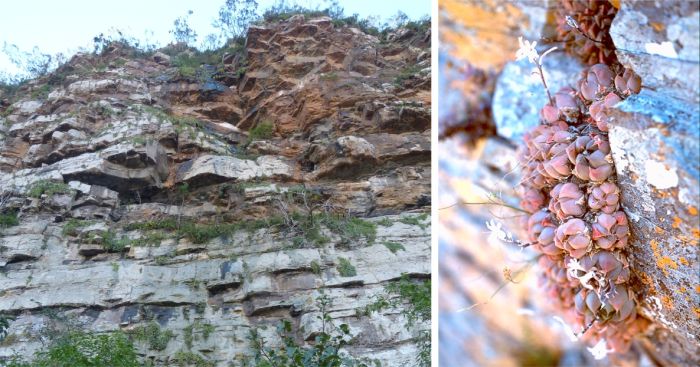
Fig. 4. Haworthia cymbiformis var. setulifera, in habitat, growing on the upper cliffs of the Mbashe River, near Colleywobbles, in the Eastern Cape.
The habitat consists of south-facing cliffs on the upper portion of the cliff face, 200–1500 m altitude. The plants are firmly rooted in crevices. Temperatures are high in summer (35–40°C). Winters are cooler but frost is absent. Rainfall occurs mainly in summer and ranges from 800–1250 mm per annum, in the form of thunder showers or cyclonic winter rain, towards the east, with rain almost absent in winter.
The associated vegetation consists of Eastern Valley Bushveld of the Savanna Biome (Mucina et al. 2006). Associated species sharing its cliff-face habitat include: Albuca batteniana, Anacampseros lanceolata, Aptenia cordifolia, Bulbine latifolia and B. thomasiae, Caputia scaposa, Coleus madagascariensis, Cotyledon orbiculata, Crassula cordata, C. intermedia, C. lactea, C. perfoliata var. minor and C. perforata, Delosperma stenandrum, Ornithogalum longibracteatum, Peperomia blanda, Senecio voigtii, Streptocarpus meyeri, and Trichodiadema sp.
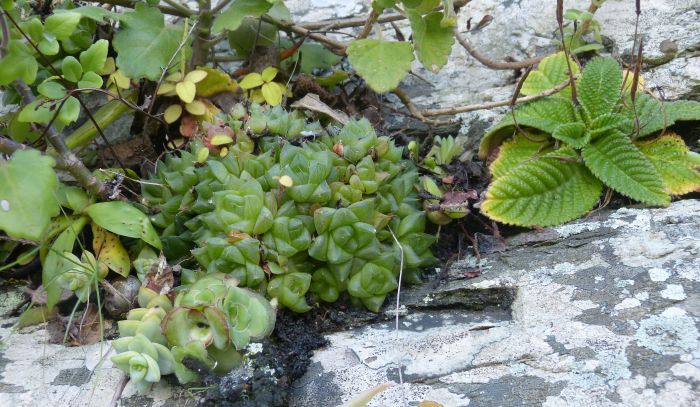
Fig. 5. A cluster of Haworthia cymbiformis var. setulifera on the Mbashe River, sharing its habitat with Coleus madagascariensis, Streptocarpus meyeri, Peperomia blanda, Crassula intermedia and C. perforata, Senecio voigtii and Albuca bracteata.
The cliffs consist of sandstone and mudstone of the Emakwezini Formation (Beaufort Group) of the Karoo Supergroup. Substrate has many ledges, crevices and fissures that are ideal for the establishment of plants.
Derivation of name and historical aspects
History
This taxon was named Haworthia planifolia var. setulifera by Karl von Poellnitz in 1938, in the journal Kakteenkunde. The variety setulifera was transferred to H. cymbiformis by Bruce Bayer in his book Haworthia Revisited in 1999. For more information on the history of Haworthia cymbiformis, see Haworthia cymbiformis var. ramosa in this series.
The varietal name setulifera, meaning ‘bearing small bristles’, is apt and pertains to the bristles on the leaf margin, which are absent from the 5 other varieties of Haworthia cymbiformis.
Haworthia cymbiformis var. setulifera is one of 7 recognised varieties (Bayer 1999). These include H. cymbiformis var. cymbiformis, var. incurvula, var. obtusa, var. ramosa, var. reddii, var. setulifera and var. transiens. This genetic variability, or plasticity, reflects its ability to adapt to local conditions and colonise new habitats. Most varieties are found predominantly on cliffs but H. cymbiformis var. ramosa and var. setulifera are strictly confined to cliff faces.
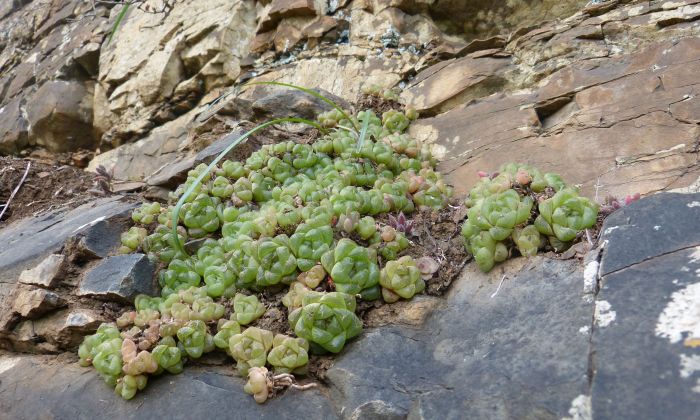
Fig. 6. A cluster of Haworthia cymbiformis var. setulifera on a south-facing cliff on the Kei River, growing with Cyrtanthus sanguineus and a seedling of Delosperma stenandrum.
Ecology
Ecology
The globose clusters grow on shady cliffs, suggesting an adaptation to maximise light absorption in its environment. The leaves are in a compact rosette, distinctly incurved, this is an adaptation to the dry cliff habitat and also regulates excessive water loss and absorption of light. The leaves are usually green, becoming pinkish during the dry periods, reducing photosynthesis. The distinct, large translucent windows guide light to the inner surface, an adaptation to the open but shaded cliff face. The leaves at the Nahoon River are less compact and further northwards at the Mbashe River the leaves become more club-shaped and compact.
The plants are long-lived, with soft leaves, withering from the base. During times of drought the leaves become flattened and channelled, becoming turgid after rain, an adaptation to the extreme, dry habitat.
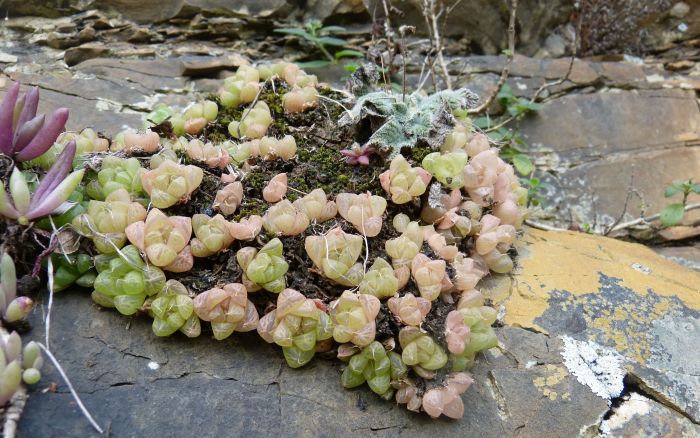
Fig. 7. A cluster of Haworthia cymbiformis var. setulifera on a south-facing cliff of the Kei River, growing with Streptocarpus meyeri and a seedling of Delosperma stenandrum.
The soft texture of the leaf and the soft teeth on the margins suggest a reduction in armament in response to the undisturbed cliff habitat, in contrast to the thorny, but heavily grazed, surrounding thicket vegetation.
The inflorescence is ascending to spreading, the two-lipped flowers (corolla) white, attracting the right pollinating flying insect. The seed is small, ideal for establishment in crevices. The seed is light, angular and shaken from the capsules and dispersed by wind. The seed ripens in summer and autumn, coinciding with the rainy season. Germination occurs within 14–21 days.
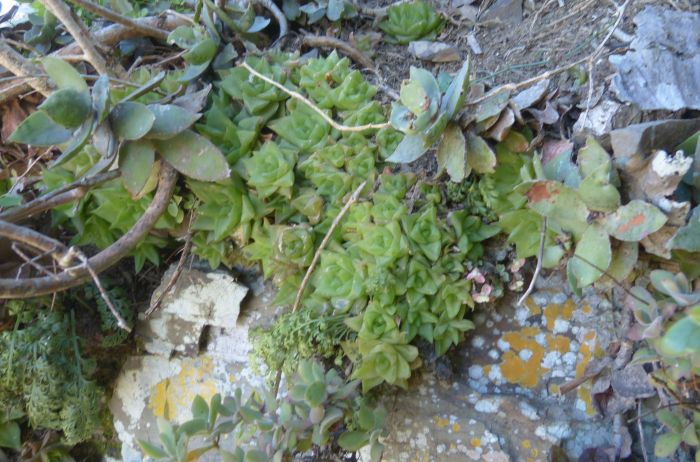
Fig. 8. A cluster of Haworthia cymbiformis var. setulifera on a south-facing cliff of the Nahoon River, growing with Crassula lactea and C. cultrata. Note the leaves that are not as compact as the Kei River or Mbashe River plants.
Haworthia cymbiformis var. setulifera suckers freely from the base, forming dense, rounded clusters. Continual sprouting from the base represents an efficient vegetative backup dispersal strategy for this harsh cliff-face environment. Detached clusters, or heads, will also root if they fall into a crevice.
Uses
Use
No uses have been recorded.

Fig. 9. A cluster of Haworthia cymbiformis var. setulifera on a south-facing, shady cliff on the Nahoon River, growing with Pelargonium inquinans, Aloe pluridens, Crassula lactea and C. orbicularis. Notice that the leaves are not as compact as the Kei River or Mbashe River plants.
Growing Haworthia cymbiformis var. setulifera
Grow
Haworthia cymbiformis var. setulifera is well-established in cultivation, very adaptable, and suitable for thicket and subtropical coastal gardens, grown on a shady embankment. Plants are of medium-growth and respond well to watering and feeding, soon filling a container. Water can be given throughout the year, but sparingly in winter.
Haworthia cymbiformis var. setulifera is easily propagated from seed or division. It performs at its best grown as a pot plant, in partial shade and kept in small containers or miniature succulent gardens, simulating the small crevices of the cliff environment. The soil should be sandy, well-drained and slightly acid, as is found in its natural habitat. They will react to any fertiliser, but organic fertilisers are best, such as well broken-down compost, applied generously throughout the year. Outside its habitat, it is best grown under controlled conditions in a greenhouse or as a pot plant, on a balcony or windowsill.
In its habitat, the cliffs of the dry river valleys in the Eastern Cape, rain is usually in summer, however some rain is also experienced in winter in the form of cyclonic cold fronts. Best to water well during summer and less so during winter. The plants are frost-sensitive and should be protected where frost can be a problem. The young plants start solitary, soon dividing to form small, dense clusters.
Plants can be divided any time of the year, but better in spring. Plant in a shallow tray in a sandy mixture (such as peat, sand and polystyrene) and kept moist. Rooting is within 3 weeks and once well-rooted transfer to individual containers. Place container in a shady position but with full light. The south side of a building is ideal.
Sow seed in spring, summer or autumn, in a sandy medium. First moisten the substrate with a fine rose. Cover the seed lightly, with a thin layer of sand. Keep moist and in a shady position. Germination is usually within 3 weeks and the young seedlings relatively fast growing. Transplant seedlings to individual containers once large enough to handle.
Plants are relatively disease free but aphids, slugs and snails can sometimes be a problem.
References
- Bayer, M.B. 1999. Haworthia revisited, a revision of the genus. Umdaus Press, Hatfield.
- Haworth, A. H. 1812. Synopsis Plantarum Succulentarum. London.
- Mucina, L. & Rutherford, M.C. (eds) 2006. The vegetation of South Africa, Lesotho and Swaziland. Strelitzia 19. South African National Biodiversity Institute, Pretoria.
- Scott, C.L. 1985. The genus Haworthia, a taxonomic revision. Aloe Books, Johannesburg.
- Van Jaarsveld, E. 2000. Wonderful waterwise gardening: a regional guide to indigenous gardening in South Africa. Tafelberg Publishers, Cape Town.
- Von Poellnitz, K. 1938. Haworthia planifolia Haw. and Haworthia perplexa V. Poelln. Kakteenkunde: 53-54, 67.
Credits
Ernst van Jaarsveld
Kirstenbosch National Botanical Garden (Retired 2015)
Babylonstoren Farm
Extraordinary senior lecturer and researcher,
Department of Biodiversity and Conservation, University of the Western Cape
June 2021
Plant Attributes:
Plant Type: Succulent
SA Distribution: Eastern Cape
Soil type: Sandy
Flowering season: Spring, Early Summer
PH: Acid, Neutral
Flower colour: White
Aspect: Shade, Morning Sun (Semi Shade), Afternoon Sun (Semi Shade)
Gardening skill: Easy
Special Features:
Horticultural zones








Rate this article
Article well written and informative
Rate this plant
Is this an interesting plant?
Login to add your Comment
Back to topNot registered yet? Click here to register.